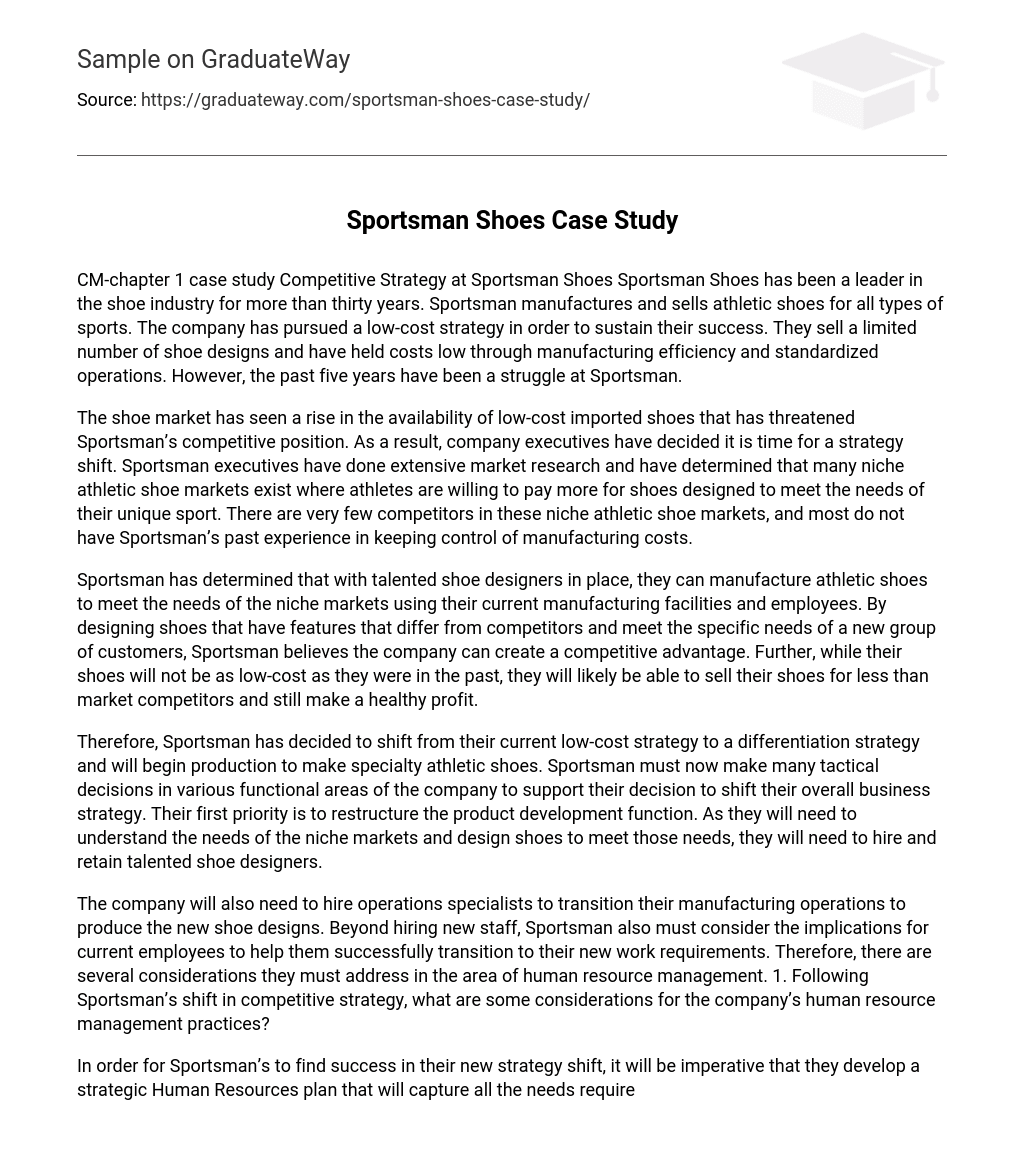Sportsman Shoes has been a leader in the shoe industry for more than thirty years. Sportsman manufactures and sells athletic shoes for all types of sports. The company has pursued a low-cost strategy in order to sustain their success. They sell a limited number of shoe designs and have held costs low through manufacturing efficiency and standardized operations. However, the past five years have been a struggle at Sportsman.
The shoe market has seen a rise in the availability of low-cost imported shoes that has threatened Sportsman’s competitive position. As a result, company executives have decided it is time for a strategy shift. Sportsman executives have done extensive market research and have determined that many niche athletic shoe markets exist where athletes are willing to pay more for shoes designed to meet the needs of their unique sport. There are very few competitors in these niche athletic shoe markets, and most do not have Sportsman’s past experience in keeping control of manufacturing costs.
Sportsman has determined that with talented shoe designers in place, they can manufacture athletic shoes to meet the needs of the niche markets using their current manufacturing facilities and employees. By designing shoes that have features that differ from competitors and meet the specific needs of a new group of customers, Sportsman believes the company can create a competitive advantage. Further, while their shoes will not be as low-cost as they were in the past, they will likely be able to sell their shoes for less than market competitors and still make a healthy profit.
Therefore, Sportsman has decided to shift from their current low-cost strategy to a differentiation strategy and will begin production to make specialty athletic shoes. Sportsman must now make many tactical decisions in various functional areas of the company to support their decision to shift their overall business strategy. Their first priority is to restructure the product development function. As they will need to understand the needs of the niche markets and design shoes to meet those needs, they will need to hire and retain talented shoe designers.
The company will also need to hire operations specialists to transition their manufacturing operations to produce the new shoe designs. Beyond hiring new staff, Sportsman also must consider the implications for current employees to help them successfully transition to their new work requirements. Therefore, there are several considerations they must address in the area of human resource management. 1. Following Sportsman’s shift in competitive strategy, what are some considerations for the company’s human resource management practices?
In order for Sportsman’s to find success in their new strategy shift, it will be imperative that they develop a strategic Human Resources plan that will capture all the needs required to facilitate the successful transition. The changes in Sportsman’s strategy will require some special considerations from the HR department. The key considerations will be, implementing a smooth transition plan that will ensure adequate training and job placement is occurring with current employees so they have a chance to succeed in the new business model.
Also, the human resources team will have to manage talent acquisition to accommodate the hiring of the proper individuals that will be needed to drive the changes to the plant and process that will occur such as engineers, managers, quality professionals, marketing experts, etc. The next key consideration for the Human Resources team will be to recommend a pay scale based on the new skill sets that will be required for the job. It will be necessary to adjust the current pay structures and manage pay and benefits to obtain and retain key talent into the organization (Armstrong, 2006).
What kind of challenges will Sportsman face specifically in the area of compensation? The key challenges faced in a transition such as Sportsman is taking on will be; Increased pay scale – Sportsman will have to substantially increase headcount, both salary and wage to accommodate the personnel necessary to successfully implement the new business strategy. This will dramatically increase pay and benefits costs to the company’s bottom line that must be considered in the price structure of the new products they sale (Armstrong, 2006).
Pay for Skills: Developing a compensation structure that is fair and equitable for the retention of key talent to avoid high turnover based on completion will be critical. Upgrading the benefits package – in order to make the company more desirable as an employee, the human resources department will need to work on a benefits and compensation package that offers health and retirement benefits to its current and future employees. Again, this will be a substantial cost that has to be calculated in the new products that are developed (Armstrong, 2006).
Reference
- Armstrong, M. (2006). Handbook of Human Resource Management Practice.





